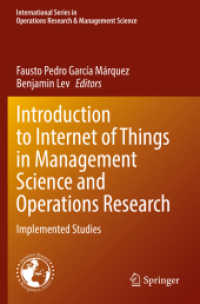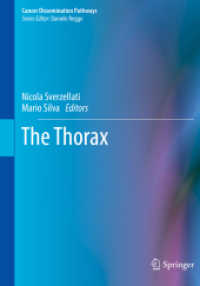- ホーム
- > 洋書
- > 英文書
- > Science / Mathematics
Full Description
Find an easier way to learn organic chemistry with Arrow-Pushing in Organic Chemistry: An Easy Approach to Understanding Reaction Mechanisms , a book that uses the arrow-pushing strategy to reduce this notoriously challenging topic to the study of interactions between organic acids and bases. Understand the fundamental reaction mechanisms relevant to organic chemistry, beginning with Sn2 reactions and progressing to Sn1 reactions and other reaction types. The problem sets in this book, an excellent supplemental text, emphasize the important aspects of each chapter and will reinforce the key ideas without requiring memorization.
Contents
Preface. Acknowledgments. About the Author . Chapter 1 Introduction. 1.1 Definition of Arrow Pushing. 1.2 Functional Groups. 1.3 Nucleophiles and Leaving Groups. 1.4 Summary. Problems. Chapter 2 Acids. 2.1 What are Acids? 2.2 What is Resonance? 2.3 How is Acidity Measured? 2.4 Relative Acidities. 2.5 Inductive Effects. 2.6 Inductive Effects and Relative Acidities. 2.7 Relative Acidities of Hydrocarbons. 2.8 Summary. Problems. Chapter 3 - Bases and Nucleophiles. 3.1 What are bases? 3.2 What are nucleophiles? 3.3 Leaving Groups. 3.4 Summary. Problems. Chapter 4 - S N 2 Substitution Reactions. 4.1 What is an S N 2 Reaction? 4.2 What are Leaving Groups? 4.3 Where can S N 2 Reactions Occur? 4.4 S N 2' Reactions. 4.5 Summary. Problems. Chapter 5 S N 1 Substitution Reactions. 5.1 What is an S N 1 Reaction? 5.2 How are S N 1 Reactions Initiated? 5.3 The Carbocation. 5.4 Carbocation Rearrangements. 5.5 Summary. Problems. Chapter 6. Elimination Reactions. 6.1 E1 Eliminations. 6.2 E2 Eliminations. 6.3 How do Elimination Reactions Work? 6.4 Summary. Problems. Chapter 7 - Addition Reactions. 7.1 Addition of Halogens to Double Bonds. 7.2 Markovnikov's Rule. 7.3 Additions to Carbonyls. 7.4 Summary. Problems. Chapter 8-Moving Forward 8.1 Functional Group Manipulations. 8.2 Name Reactions. 8.3 Reagents. 8.4 Final Comments. Problems. Appendix 1-pK a Values of Protons Associated with Common Functional Groups. Appendix 2-Answers and Explanations to Problems. Chapter 1 Solutions. Chapter 2 Solutions. Chapter 3 Solutions. Chapter 4 Solutions. Chapter 5 Solutions. Chapter 6 Solutions. Chapter 7 Solutions. Chapter 8 Solutions. Appendix 3-Student Reaction Glossary. Index. Periodic Table of the Elements.



![チェス - 携帯に便利な折りたたみボードのチェス! [バラエティ] NAGAOKA BOARD GAME](../images/goods/../parts/goods-list/no-phooto.jpg)




